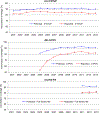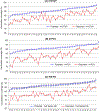Evaluation of potentially achievable vaccination coverage with simultaneous administration of vaccines among children in the United States
- PMID: 27160040
- PMCID: PMC6714559
- DOI: 10.1016/j.vaccine.2016.04.097
Evaluation of potentially achievable vaccination coverage with simultaneous administration of vaccines among children in the United States
Abstract
Background: Routine administration of all age-appropriate doses of vaccines during the same visit is recommended for children by the National Vaccine Advisory Committee (NVAC) and the Advisory Committee on Immunization Practices (ACIP).
Methods: Evaluate the potentially achievable vaccination coverage for ≥4 doses of diphtheria and tetanus toxoids and acellular pertussis vaccine (4+DTaP), ≥4 doses of pneumococcal conjugate vaccine (4+PCV), and the full series of Haemophilus influenzae type b vaccine (Hib-FS) with simultaneous administration of all recommended childhood vaccines. Compare the potentially achievable vaccination coverage to the reported vaccination coverage for calendar years 2001 through 2013; by state in the United States and by selected socio-demographic factors in 2013. The potentially achievable vaccination coverage was defined as the coverage possible for the recommended 4+DTaP, 4+PCV, and Hib-FS if missed opportunities for simultaneous administration of all age-appropriate doses of vaccines for children had been eliminated.
Results: Compared to the reported vaccination coverage, the potentially achievable vaccination coverage for 4+DTaP, 4+PCV, and Hib-FS could have increased significantly (P<0.001), the vaccination coverage would have achieved the 90% target of Healthy People 2020 for the three vaccines beginning in 2005, 2008, and 2011 respectively. In 2013, the potentially achievable vaccination coverage increased significantly across all selected socio-demographic factors, potentially achievable vaccination coverage would have reached the 90% target for more than 51% of the states in the United States.
Conclusions: The findings in this study suggest that fully utilization of all opportunities for simultaneous administration of all age-eligible childhood doses of vaccines during the same vaccination visit is a critical strategy for achieving the vaccination coverage target of Healthy People 2020. Encouraging providers to deliver all recommended vaccines that are due at each visit by implementing client reminder and recall systems might decrease missed opportunities for simultaneous administration of childhood vaccines.
Keywords: Age appropriate; Childhood vaccines; Healthy People 2020 target; Potentially achievable; Simultaneous administration; Vaccination coverage.
Published by Elsevier Ltd.
Conflict of interest statement
Figures


References
-
- National Vaccine Advisory Committee. Standards for child and adolescent immunization practices. Pediatrics 2003;112(958):63. - PubMed
-
- Centers for Diseases Control Prevention. Recommendations of the Advisory Committee on Immunization Practices (ACIP). MMWR 2011;60(January (RR02)):1–60. - PubMed
-
- King GE, Hadler SC. Simultaneous administration of childhood vaccines: an important public health policy that is safe and efficacious. Pediatr Infect Dis J 1994;13:394–407. - PubMed
-
- US Department of Health and Human Services. Healthy people 2020 objectives, immunization and infectious diseases. http://www.healthypeople.gov/2020/topics-objectives/topic/immunization-a....
-
- Centers for Diseases Control Prevention. Immunization strategies for healthcare practices and providers Epidemiology and prevention of vaccine-preventable diseases. The pink book: course textbook; 13th ed; 2015.
Publication types
MeSH terms
Substances
Grants and funding
LinkOut - more resources
Full Text Sources
Other Literature Sources
Medical

